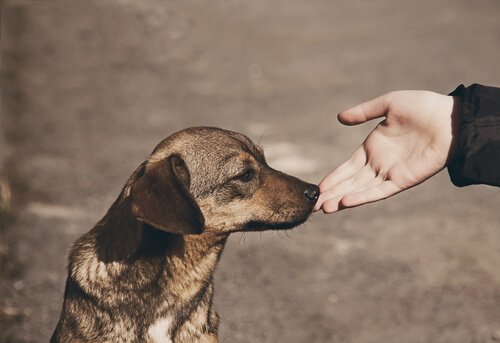How to Approach a Dog You Don’t know

If you’re someone who loves animals and you worry about them, you’ll probably try to approach a dog in the street that looks lost or abandoned. In order to this, you will try your best to get closer to help them. However, before trying to get close to a dog you don’t know, you need to take several precautions. This can prevent them from misinterpreting your intentions and reacting badly.
What you need to keep in mind before approaching a dog you don’t know
Before getting close to a dog you don’t know, you need to study their body language and read the signals they’re giving off. Drop the idea of approaching them if they are showing signs of aggression. For instance:

- Barking and growling.
- Showing their teeth.
- Ears forward.
- Tail straight.
- Legs stiff.
- Fur standing up.
In cases like this, the likelihood of the animal trying to bite you is much greater. It might even be a good idea to call the dog catcher so they can help rescue them.
In order to successfully approach a dog that you don’t know, the first thing you need to do is know how to interpret their body language.
How you should approach a dog you don’t know
If their fur gives off the impression that the dog is friendly, or at least they aren’t any signs of aggression, then try to get them to approach you. If they won’t, you can slowly approach them from the side. Follow the advice below:
- Don’t talk loudly, rather use a calming, loving tone.
- Don’t make sudden movements or try to corner them.
- Avoid looking at them for too long. The animal can consider it as challenging and a sign you think you’re dominant.
- Stick your hand out so that they can smell it. This is a way of showing them you have good intentions.
- Pet them softly, preferably on the back.
- Squat so they can see you’re on their level.
If you see that they are reticent, back up and try to pet them again after a few minutes. And, keep in mind that if the dog is wagging his tail, this isn’t always a sign of happiness. This could be a clear sign that they’re agitated and nervous.
What to do after you’ve approached the dog
If you get their approval, try to check and see if they have any tags so you can call its owners. They might also have a microchip.
If the dog doesn’t have any identification, and you can get them to follow you, or put a leash on them, then take them to a vet. Take them home or to a friend’s house in the meantime. Or as a last resort, you can take them to a shelter.
The best thing to do is to keep trying to find out if the dog has any owners. After all, the dog might have lost their tags somewhere. Put up posters and use social media and other forms of communication. Look through or publish an advertisement in the newspaper.
If you don’t get any good results, it’s time to look for a new home for them. At this point, you might have gotten attached to the dog and decide to adopt it.
Times when you shouldn’t ever approach a dog
Never approach or try to touch a dog you don’t know that’s:
- Chained or tied up.
- Kept in a cage, corral, etc.
- Behind a fence.
- In a car.
- Sleeping or hasn’t noticed you.
- Sick.
- Has puppies.
- Eating.
In all of these cases, the dog will be aggressive. This could be because they’re afraid or defending their territory. You should also resist the temptation to pet a dog that is being walked. You should always ask permission first and wait for the owner to answer you.
Responsibility, first and foremost

It’s important that you explain to your children that they shouldn’t approach or try to approach a dog they don’t know. It doesn’t matter how much they like animals.
It’s also important to explain to your children what to do if an animal starts to act aggressively with them.
Keep in mind, knowing dogs’ body language is supremely important in such cases. This will allow you to successfully approach a dog you don’t know. That way you can help them find their owners or find a foster home, which could even be yours.